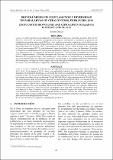Por favor, use este identificador para citar o enlazar este ítem:
https://hdl.handle.net/20.500.12958/7532| Título : | Biovolúmenes de zooplancton y diversidad de paralarvas de cefalópodos, primavera 2019 |
| Otros títulos : | Zooplankton biovolumes and cephalopod paralarvae diversity (spring 2019) |
| Autor : | Orosco, Ximena |
| Palabras clave : | Biovolúmenes;Zooplancton;Cefalópodos;Paralarvas |
| Fecha de publicación : | mar-2023 |
| Editorial : | Instituto del Mar del Perú |
| Citación : | Orosco, X. (2023). Biovolúmenes de zooplancton y diversidad de paralarvas de cefalópodos, primavera 2019. Inf Inst Mar Perú, 50(1), 60-67. |
| Citación : | Informe IMARPE 50(1), 2023; |
| Resumen : | Se describe la composición de especies, distribución y abundancia de paralarvas de cefalópodos durante la primavera del 2019, así como los biovolúmenes de zooplancton, recolectados con una red Bongo de 300 micras desde 40 hasta 200 mn de distancia de la costa. Los biovolúmenes de zooplancton fluctuaron entre 5,5 y 341,3 mL.100 m-3 con mediana de 28,3 mL.100 m-3, donde el rango de 20 - 50 mL.100 m-3 fue el más frecuente (50,7 %), ubicándose en 2 áreas focalizadas (norte y sur). Se determinó 11 familias y 10 especies de cefalópodos en 67 muestras de zooplancton. El género Argonauta fue el más frecuente (70,9 %) y abundante (72,1 %), seguido de Sthenoteuthis oualaniensis – Dosidicus gigas (Complejo S-D) con 8,6 % y 8,9 %, respectivamente. La distribución espacial de Ctenopteryx sicula y Gonatidae estuvieron en el sur, a diferencia de Pterygioteuthis hoylei, Planctoteuthis sp.1, Onychoteuthis sp., Histioteuthis sp. y Enoploteuthidae que se encontraron solo en la zona norte. Asimismo, Argonauta spp. y el Complejo S-D tuvieron distribución más homogénea a lo largo del litoral, siempre asociados a las Aguas Subtropicales Superficiales. ABSTRACT: In the spring of 2019, a study was conducted to analyze the composition, distribution, and abundance of cephalopod paralarvae, as well as the biovolumes of zooplankton. Zooplankton samples were collected using a 300-micron mesh Bongo net, at distances ranging from 40 to 200 nm offshore. Zooplankton biovolumes were observed to vary between 5.5 and 341.3 mL.100 m-3 with a median value of 28.3 mL.100 m-3. The most frequent range of biovolumes observed was between 20 and 50 mL.100 m-3, accounting for 50.7% of the total biovolume sampled. These biovolumes were concentrated in two focal areas, the northern and southern zones. A total of eleven families and ten cephalopod species were identified in the 67 zooplankton samples collected. The most abundant (72.1%) and frequent (70.9%) genus was Argonauta, followed by Sthenoteuthis oualaniensis - Dosidicus gigas (S-D Complex) at 8.6% and 8.9%, respectively. The southern zone was observed to host Ctenopteryx sicula and Gonatidae, whereas Pterygioteuthis hoylei, Planctoteuthis sp.1, Onychoteuthis sp., Histioteuthis sp., and Enoploteuthidae were only found in the northern zone. Argonauta spp. And the S-D Complex exhibited a more homogeneous distribution along the coast, being consistently associated with Subtropical Surface Waters. |
| URI : | https://hdl.handle.net/20.500.12958/7532 |
| ISSN : | 0378-7702 |
| Aparece en las colecciones: | Informe vol. 50(1) 2023 |
Ficheros en este ítem:
| Fichero | Descripción | Tamaño | Formato | |
|---|---|---|---|---|
| Informe 50-1 articulo 5.pdf | 636,22 kB | Adobe PDF |  Visualizar/Abrir |
Este ítem está sujeto a una licencia Creative Commons Licencia Creative Commons

